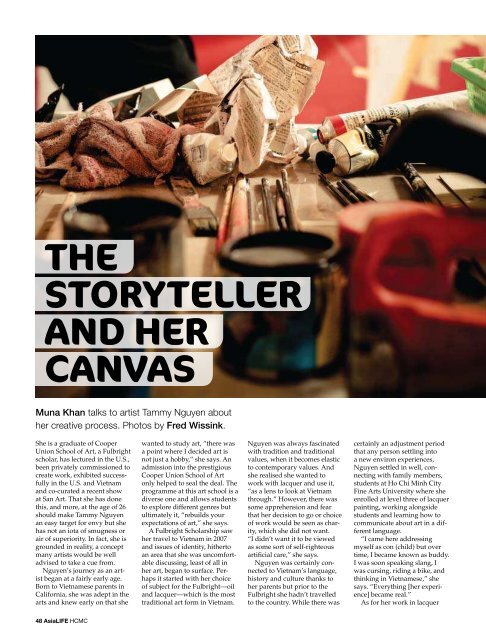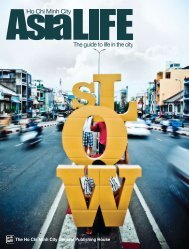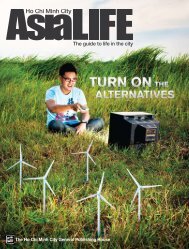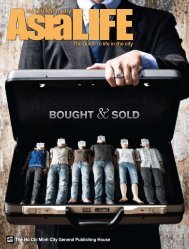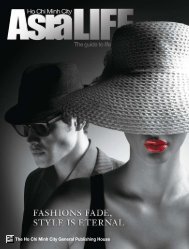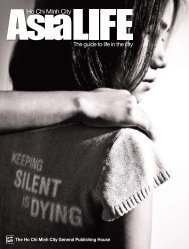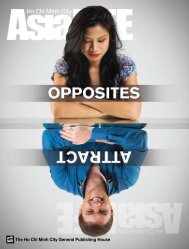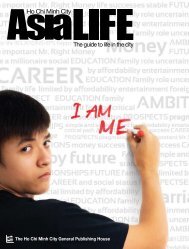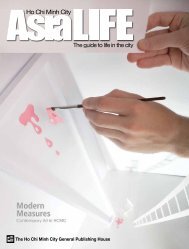transition - AsiaLIFE Magazine
transition - AsiaLIFE Magazine
transition - AsiaLIFE Magazine
- No tags were found...
You also want an ePaper? Increase the reach of your titles
YUMPU automatically turns print PDFs into web optimized ePapers that Google loves.
THESTORYTELLERAND HERCANVASMuna Khan talks to artist Tammy Nguyen abouther creative process. Photos by Fred Wissink.She is a graduate of CooperUnion School of Art, a Fulbrightscholar, has lectured in the U.S.,been privately commissioned tocreate work, exhibited successfullyin the U.S. and Vietnamand co-curated a recent showat San Art. That she has donethis, and more, at the age of 26should make Tammy Nguyenan easy target for envy but shehas not an iota of smugness orair of superiority. In fact, she isgrounded in reality, a conceptmany artists would be welladvised to take a cue from.Nguyen’s journey as an artistbegan at a fairly early age.Born to Vietnamese parents inCalifornia, she was adept in thearts and knew early on that shewanted to study art, “there wasa point where I decided art isnot just a hobby,” she says. Anadmission into the prestigiousCooper Union School of Artonly helped to seal the deal. Theprogramme at this art school is adiverse one and allows studentsto explore different genres butultimately it, “rebuilds yourexpectations of art,” she says.A Fulbright Scholarship sawher travel to Vietnam in 2007and issues of identity, hithertoan area that she was uncomfortablediscussing, least of all inher art, began to surface. Perhapsit started with her choiceof subject for the Fulbright—oiland lacquer—which is the mosttraditional art form in Vietnam.Nguyen was always fascinatedwith tradition and traditionalvalues, when it becomes elasticto contemporary values. Andshe realised she wanted towork with lacquer and use it,“as a lens to look at Vietnamthrough.” However, there wassome apprehension and fearthat her decision to go or choiceof work would be seen as charity,which she did not want.“I didn’t want it to be viewedas some sort of self-righteousartificial care,” she says.Nguyen was certainly connectedto Vietnam’s language,history and culture thanks toher parents but prior to theFulbright she hadn’t travelledto the country. While there wascertainly an adjustment periodthat any person settling intoa new environ experiences,Nguyen settled in well, connectingwith family members,students at Ho Chi Minh CityFine Arts University where sheenrolled at level three of lacquerpainting, working alongsidestudents and learning how tocommunicate about art in a differentlanguage.“I came here addressingmyself as con (child) but overtime, I became known as buddy.I was soon speaking slang, Iwas cursing, riding a bike, andthinking in Vietnamese,” shesays. “Everything [her experience]became real.”As for her work in lacquerpainting, there was muchresearch on the subject, andmuch to practice in skill for theprocess of layering in lacquerpainting is time-consuming andrequires patience. Elements ofthe layering would be foundagain in Nguyen’s Novemberexhibition “My Diary from thatBattle of 10,000 Ships” in Novemberlast year, proving howvaluable her academic researchand subsequent work experiencewas and how it continuesto influence and shape the artist’swork.It is always difficult to explainan artist’s creative process anddespite Nguyen’s articulatenessand the passion with which shedescribes her approach to herown work, she is influencedby a myriad of elements, manyof which are too long to list orbreak down into mere words.They are, however, fascinatingconcepts to listen to as she isanimated in her description andeach canvas has an incrediblestory behind its evolution. Forexample, a tree stump thatmetamorphosed into actionheroes—that process could beinfluenced by the action moviesshe loves or the game theorybooks she was reading or theWorld Cup last summer she wasavidly following.What seems constant, is thenotion of balance, whether oneis searching for it or trying toremain in that stance havingfound it. Her solo exhibition atL’Usine in November, for example,illustrates the nature ofcombat and how one strugglesto achieve some form of balance.The installation featuredpaper, silk, thread and ink wasa representation of battle scarsendured through hardships andstemmed from the artist’s explorationof “the battle betweenpower and sensuality”. In otherwork, aspects of combat alsoappear, which Nguyen says, isof interest. “I’m interested in thestrategies behind combat, theway one develops habits thatturn into combat.” And if one isto expound on it, perhaps wheretradition weaves into it.Nguyen chose to stay onafter the Fulbright and todaybalances a full-time job at MyDuc Ceramics (tile manufacturers)and working on her art,usually twice a day, in variousmediums. In between she workson projects like co-curating anexhibit “Chi Toi” (My ElderSister) at San Art. What she doesnot do is worry about sellingher work. “My only concern isto ensure that my work looksgood, that it is elegant,” she tellsme. “Every artist has a crutchand mine is beauty; the subjectcan be the same but the mediumwill be different.”Her last exhibition, a solo atL’Usine in October, was titled “MyBattle with 10,000 Ships”.48 asialife HCMC asialife HCMC 49


